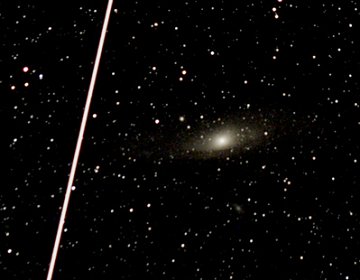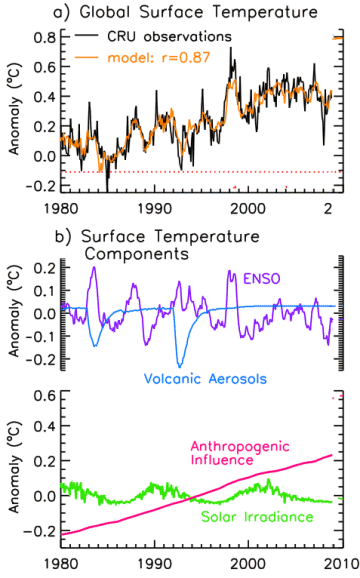| ARE SUNSPOTS DISAPPEARING? The sun is in the pits of the deepest solar minimum in nearly a century. Weeks and sometimes whole months go by without even a single tiny sunspot. Are sunspots disappearing? Experts discuss the question in today's story from Science@NASA. BUZZING ANDROMEDA: Residents of the Andromeda galaxy experienced a close encounter on Sept. 3rd. That's when Ugur Ikizler of Bursa, Turkey, photographed a spaceship streaking past the great spiral: 
Photo details: Canon Rebel XT, Hutech modified, ISO 800, 39 sec
It was the International Space Station (ISS). The International Space Station is streaking among the stars of the night sky with space shuttle Discovery in tow. Discovery is visiting the ISS to deliver a load of laboratory equipment. The new hardware will kickstart onboard research in low-gravity fluid physics, crystal growth and semiconductor development, among other things. Buzzing Andromeda was purely extracurricular. What will the two spaceships encounter next? See for yourself. The Simple Satellite Tracker tells when to look. SOLAR MINIMUM VS. GLOBAL WARMING: From 2002 to 2008, decreasing solar irradiance has countered much anthropogenic warming of Earth's surface. That's the conclusion of researchers Judith Lean (NRL) and David Rind (NASA/GISS), who have just published a new analysis of global temperatures in the Geophysical Research Letters. Lean and Rind considered four drivers of climate change: solar activity, volcanic eruptions, ENSO (El Nino), and the accumulation of greenhouse gases. The following plot shows how much each has contributed to the changing temperature of Earth's surface since 1980: 
Volcanic aerosols are a source of cooling; ENSO and greenhouse gases cause heating; the solar cycle can go either way. When added together, these factors can account for 76% of the variance in Earth's surface temperature over the past ~30 years, according to the analysis of Lean and Rind. Several aspects of their model attract attention: "The warmest year on record, 1998, coincides with the 'super-El Nino' of 1997-98," points out Lean. "The ESNO is capable of producing significant spikes in the temperature record." Solar minimum has the opposite effect: "A 0.1% decrease in the sun's irradiance has counteracted some of the warming action of greenhouse gases from 2002 - 2008," she notes. "This is the reason for the well-known 'flat' temperature trend of recent years." What's next? Ultimately, the authors say, temperatures will begin rising again as greenhouse gases accumulate and solar activity resumes with the coming of the next solar cycle. Of couse, the solar cycle could be out of whack; if solar minimum deepens and persists, no one is certain what will happen. Lean and Rind reveal their predictions for the future here. Reference: Lean, J. L., and D. H. Rind (2009), How will Earth's surface temperature change in future decades?, Geophys. Res. Lett., 36, L15708
August 2009 Aurora Gallery
[previous Augusts: 2008, 2007, 2006, 2005, 2004, 2003, 2002, 2001]
Explore the Sunspot Cycle | 
